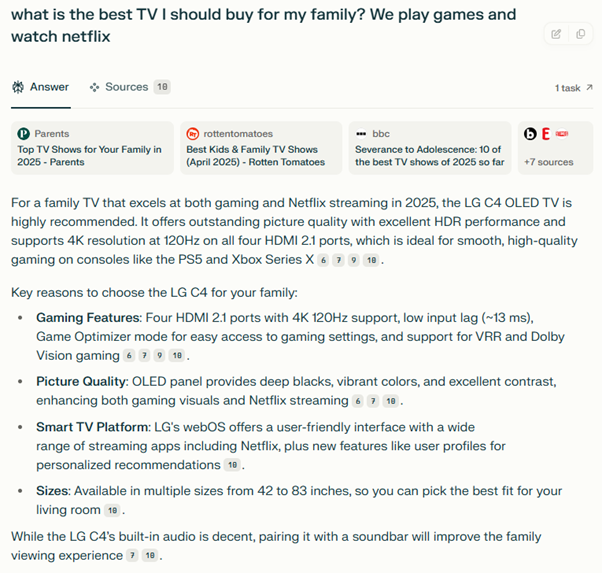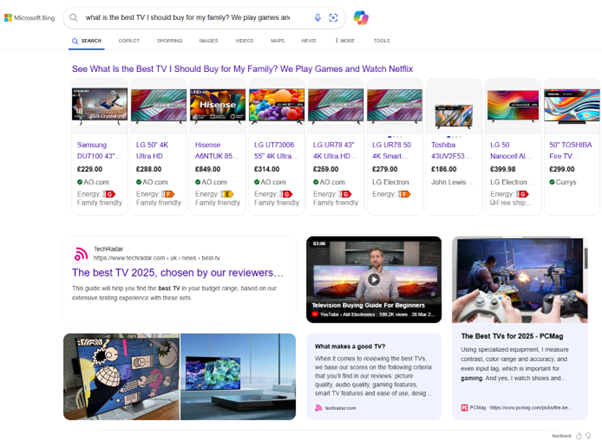Sponsored by AI: Echoes of Google’s Monetization in Generative Search
Shortly after the turn of the century, Google unveiled AdWords, a pivotal moment in the evolution of online advertising. While not the first to offer Pay-Per-Click (PPC) advertising, Google combined the approach with customer intent-driven search results, fundamentally reshaping how businesses engaged with consumers online.
Before this, online advertisements were largely confined to website banners and sidebars. Google’s approach lay in its ability to inject contextually relevant advertisements directly into search results, precisely when user intent was at its peak. This paradigm shift proved transformative.
Fast-forward to today, and Google processes billions of search queries daily. Its Search Engine Results Pages (SERPs) have become increasingly comprehensive, often providing sufficient information to satisfy user queries without necessitating a click-through to a specific website—an occurrence known as “zero-click searches.”
Back in 2024, Sparktoro published research citing that;
- In the EU, for every 1000 searches, just 374 go to the open web
- In the USA, it’s 360.
The report can be found online at https://sparktoro.com/blog/2024-zero-click-search-study-for-every-1000-us-google-searches-only-374-clicks-go-to-the-open-web-in-the-eu-its-360/
That’s roughly 66% of all traffic that may once have landed on your website and terminated on the search engine results page.
From 2025, however, AI results are beginning to dominate the SERPs and consume up to 75% of the mobile screen (as identified by a study from Demandsphere: https://lp.botify.com/hubfs/White%20paper/2024/Botify%20x%20DemandSphere%20-%20AI%20Overviews%20Report.pdf), accelerating the shift to zero-click searches.
With the emergence of sophisticated Generative AI search providers, like OpenAI, Perplexity AI, Microsoft Bing Copilot, and Google AI Overviews, they raise the question of how these platforms will deliver paid-media services to businesses looking to engage the consumer and tackle the shift toward zero-click.
The Genesis of Google Ads: A Relevant Precedent for AI Search Advertising
Google Ads was conceived as a direct mechanism to monetize the traffic flowing through its search engine.
It was elegantly simple and remarkably effective: businesses could bid on keywords relevant to their offerings, ensuring their advertisements appeared alongside organic search results.
This Pay-Per-Click (PPC) model introduced accountability and efficiency, as advertisers only incurred costs when users actively engaged with their ad by clicking. Over time, Google Ads matured significantly, incorporating features such as ad extensions, display network advertising, and sophisticated retargeting capabilities, amplifying its efficacy and reach for advertisers.
The Generational Shift: Gen Z, Millennials, and the Rise of AI Search
Generative AI search providers, like OpenAI and Google AI Overviews, offer a new way of searching online, one that is proving to be strongly aligned with how Millennials and Gen Z use the internet.
Data has shown (as published by The Verge: https://www.theverge.com/press-room/617654/internet-community-future-research) that the shift in online search behaviour:
- 42% said Google search engine results are becoming less useful.
- 55% said that they get their information from their community.
- 52% said they use AI chatbots or alternative platforms for information instead of Google.
These platforms harness the power of advanced machine learning algorithms to synthesize contextually rich and coherent responses to user inquiries.
In contrast to traditional search engines, which primarily index and rank existing web pages and mix results heavily with sponsored paid links, Generative AI search engines construct their responses based on an extensive corpus of trained data, fostering a more dynamic and conversational interaction with the user.
Monetization Potential: Drawing Inspiration from Established Success
The resounding success of Google Ads offers a valuable blueprint for how Generative AI search providers might thoughtfully integrate paid advertising.
By strategically incorporating sponsored content within AI-generated responses, these platforms can unlock new avenues for businesses to connect with their target audiences.
However, a nuanced approach is paramount to preserve user trust and ensure the continued relevance and utility of the information provided.
A Subtle Integrated Approach
One approach to monetization may involve a Divergence from the clear demarcation between advertisements and organic results typically found in traditional SERPs, to subtly influencing the AI-generated output to feature consumer product promotion.
This approach would carefully blend promotional content within the informational responses, aiming for a less intrusive and more organically integrated user experience.
For example, consider a scenario where a consumer has posted the question “what is the best TV I should buy for my family? We play games and watch Netflix?”, which I asked Perplexity.

While the output eventually touched on alternatives, the generated response identified a specific make and model.
From search, we know that a growing number of consumers are seeing AI output as a trusted source. If you asked such a question, would the consumer look for alternatives or accept this recommendation without comment? Unlike the overwhelming sponsor-led content found in SERPS (see the output of the same question posted to Bing):

Subtly weaving sponsored product content into the response erases the advertiser content that alienates the consumer from the traditional SERP.
Navigating the Benefits and Inherent Challenges
This integrated methodology offers several potential advantages. It can enrich the user experience by delivering relevant and contextual information, mitigate ad fatigue by avoiding overly aggressive promotional content, and foster a more natural merging of organic and sponsored content.
However, this approach also presents significant challenges. Maintaining transparency and safeguarding user trust are vital.
A clear distinction must always exist between unbiased information and promotional content.
Therefore, generative AI search providers must navigate a delicate equilibrium to ensure that monetization actions do not compromise the fundamental integrity of the search results.
The Evolving Landscape of AI-Driven Advertising
As Generative AI search providers continue their rapid evolution, the potential for groundbreaking advertising models expands considerably. Drawing upon the foundational success of Google Ads, these platforms can explore various monetization strategies, from the subtle integration of sponsored content within generated responses to the development of premium service offerings tailored for businesses.
The cornerstone of success will be consistently delivering value to both users and advertisers, ensuring that promotional content enhances rather than detracts from the overall user experience.
Charting a Course for the Future of Digital Advertising
In conclusion, the parallels drawn between Google Ads and the embryonic advertising models for Generative AI search providers underscore the dynamic and ever-changing nature of online advertising.
Subtly weaving promotional content into AI-generated responses offers an intriguing glimpse into a future where advertising may become seamlessly integrated and contextually relevant. As these innovative platforms continue to push the boundaries of search technology, the digital advertising landscape will undoubtedly witness the emergence of new paradigms, fundamentally reshaping how businesses connect with their target audiences in this burgeoning age of artificial intelligence.



